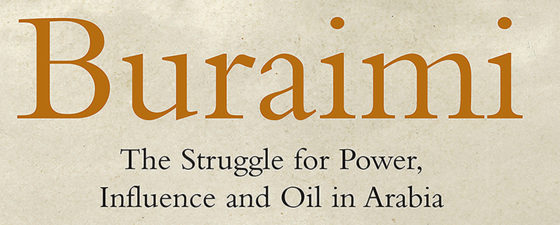Buraimi and Al Ain are twin towns that today sit astride the fenced border between Oman and the United Arab Emirates. In the 19th century, Buraimi village was occupied by Wahhabis at several periods and used as a base for raiding and converting the local tribes to their form of Islam. By the mid 20th century there were nine separate oasis villages where the tribes owed allegiance, three to the Sultan of Oman (Buraimi, Hamasa and Saara) and six to the Ruler of Abu Dhabi (Al Ain, Hili, Jimi, Murtiridh, Muwaiqi and Qattarah). These villages lay on the desert caravan routes from inner Oman to the coastal ports of Sharjah, Dubai, Abu Dhabi and Sohar and were famed for trade in the needs of the day, including slaves in Hamasa. Wilfred Thesiger stayed with Sheikh Zayed in Muwaiqi on a number of occasions in the 1940s during his crossings of the Empty Quarter.
Countries Versus Companies
 A decade or so earlier, when American and British-based oil companies began exploring for oil in Arabia, there were few established borders between countries. Tribes had allegiances to sheikhs and leaders, settled tribes lived in segregated parts of villages and towns, and desert bedouin tribes had established grazing areas and water wells.
A decade or so earlier, when American and British-based oil companies began exploring for oil in Arabia, there were few established borders between countries. Tribes had allegiances to sheikhs and leaders, settled tribes lived in segregated parts of villages and towns, and desert bedouin tribes had established grazing areas and water wells.
Early oil concessions were often poorly defined and rulers sometimes struggled to ensure access to territories over which they had only nominal influence. Meanwhile, Bahrain field was discovered in 1932, Dammam in 1938, Dukhan in 1940 and the game-changing Ghawar in 1948. There was a belief that the prolific Arab Zone oil reservoirs of these fields might extend throughout SE Arabia. In their revised 1948 contract Aramco had commitments to explore the whole of its ill defined concession and to relinquish 85,000 km2 every three years. The Iraq Petroleum Company (IPC) was also busy trying to make headway exploring for oil in Qatar, the Trucial States (later the U.A.E), Oman and Dhofar. Early in 1948, their geologists spotted the ‘beautiful’ Fahud anticline in the foothills of the Al Hajar Mountains that became the focus of their exploration effort in Oman.
 It is against such background that Quentin Morton weaves the story of the Buraimi dispute played out between the rulers of Saudi Arabia, Abu Dhabi and Oman; the British and American governments with their respective declining and rising influence in the region, Britain looking after the external affairs of a number of Gulf States at that time; and the oil companies Aramco and IPC. The essence of the dispute: in response to diplomatic exchanges between Britain and Saudi Arabia over incursions by Aramco exploration parties into what was regarded as the territory of the Ruler of Abu Dhabi, Saudi Arabia laid claim to Buraimi and much of Abu Dhabi. The border with Oman was undefined, perhaps to adopt a bedouin tactic of having captured one water-well or place, you then laid claim to the next. This was followed in August 1952 by the arrival of a 50-strong Saudi contingent in the Omani village of Hamasa, the British intervening to stop them being expelled by the combined forces of the Omani Sultan and Imam, a blockade by the Trucial Oman Scouts, a failed attempt at arbitration in Geneva and the eventual forceful removal of the Saudis and their sympathisers in October 1955.
It is against such background that Quentin Morton weaves the story of the Buraimi dispute played out between the rulers of Saudi Arabia, Abu Dhabi and Oman; the British and American governments with their respective declining and rising influence in the region, Britain looking after the external affairs of a number of Gulf States at that time; and the oil companies Aramco and IPC. The essence of the dispute: in response to diplomatic exchanges between Britain and Saudi Arabia over incursions by Aramco exploration parties into what was regarded as the territory of the Ruler of Abu Dhabi, Saudi Arabia laid claim to Buraimi and much of Abu Dhabi. The border with Oman was undefined, perhaps to adopt a bedouin tactic of having captured one water-well or place, you then laid claim to the next. This was followed in August 1952 by the arrival of a 50-strong Saudi contingent in the Omani village of Hamasa, the British intervening to stop them being expelled by the combined forces of the Omani Sultan and Imam, a blockade by the Trucial Oman Scouts, a failed attempt at arbitration in Geneva and the eventual forceful removal of the Saudis and their sympathisers in October 1955.
It is perhaps a blessing that the early exploration wells in the U.A.E. and Oman were dry or teasers, as major oil discoveries onshore Abu Dhabi or inner Oman in the mid 1950s would have only added fuel to the fire, as indeed the cross-border discoveries at Shaybah and Zarrara must have done in 1968. The borders were unilaterally drawn by Britain before it withdrew from the Gulf and finally agreed by the rulers of Saudi Arabia, Qatar, Abu Dhabi and Oman, along with the ownership of the giant Shaybah field.
A Different Outcome
There are several previous accounts that touch on the Buraimi dispute, but none I have read so extensively researched from such diverse sources. For those interested in the recent history of the U.A.E. and Oman, this book provides an intriguing background to events and consequences that, even today, continue to unfold.
As the author concludes, ‘If Buraimi had fallen to the Saudis, many of the oilfields in Abu Dhabi and Oman (and most if not all of their territory) would probably belong to Saudi Arabia today.’ It would be a rather different Middle East and world order.





